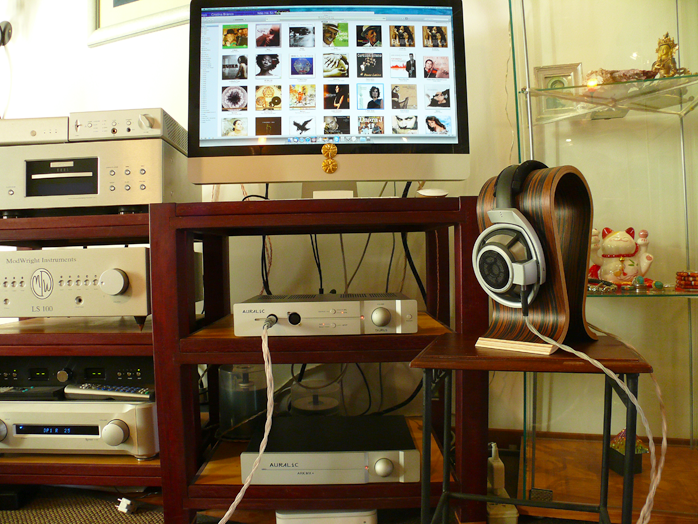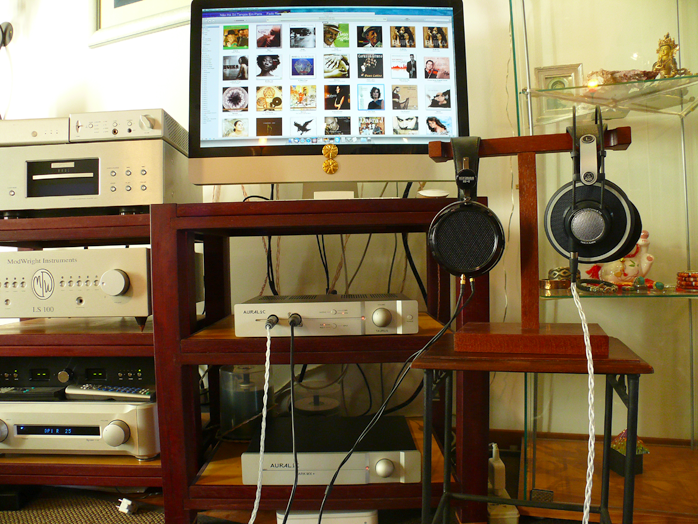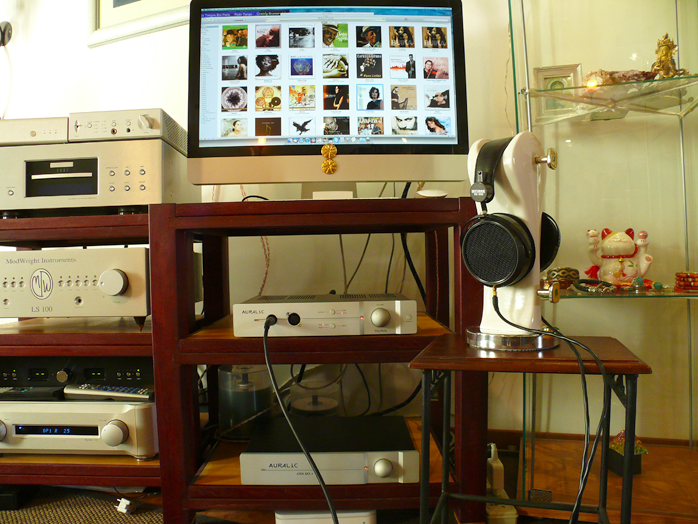This review page is supported in part by the sponsors whose ad banners are displayed below |
 |
 |
|
 |
Sennheiser HD800 (headphone stand by Sieveking Sound, Sennheiser wiring by ALO Audio)
|
Nits & nyets. As the preceding explained, separation of RCA/XLR paths isn't absolute. It applies to the XLRs only. I thus was surprised how that mode still showed some signal on the 6.3mm jack - seriously attenuated signal but not complete silence. There was minor cross bleed. My HifiMan HE6 sports an XLR termination plus 6.3mm pig tail to go either way. When deciding which port one prefers, it's important to account for the voltage differential between them. Otherwise the louder one will sound better by default. Not having balanced wiring except for the HE6/HE5-LE, I couldn't weigh in on recommended combinations.
|
 |
Perfect break-in: HifiMan HE6 and AKG K702 simultaneously (headphone stand and AKG wiring by ALO Audio)
|
One occasional glitch was trying to go to the BAL inputs with a balanced cable connected already. The relevant switch refused to leave STD. Eventually it would however. Which leaves a nyet rather than nit. Like the competing April Music Eximus DP1 which essentially packages ARK MX+ and Taurus into one chassis while shaving $800 off their combined $3,798 sticker, AURALiC gives us no wand. That also makes their preamp functionality less than fully contemporary. Insert the usual explanations about price and performance as to why remote control wasn't included. While quibbling, I'd definitely also want dedicated selectors for the headphone ports to activate either or its matching line output. Resonessence Labs' Invicta is a perfect example for how to implement this elegantly. To me AURALiC's rationale for no such selectors—marring the simplicity of their fascia—lacks conviction.
|
 |
Audez'e LCD-2 (stand by Klutz Design, Audez'e wiring by ALO Audio)
|
|
|
Sparing you a blow-by-blow account through my arsenal of cans, let's jump right into the deep end. The Taurus was truly fabulous on all of them. A good demonstrator will be the Sennheiser HD800. Most agree that its stock voicing exhibits an abundance of treble energy whilst the bass counterpoint is lighter than Beyerdynamic's T1 and significantly outclassed by the Audez'e LCD-2. An aftermarket wiring harness—I get all my braids from ALO Audio's Ken Ball—goes a long way to sort this. Yet nobody will ever mistake an HD800 for an LCD-2. True, the latter is famously chocolaty and dense and thus a bit hooded on top. If you love those orthodynamics as I do, you're by design less smitten with the antithesis of the HD800 (and by extension also the HE6 which are the Sennheisers of planars but got nicely rebalanced as the HE500). Yet in the absence of AKG's K1000 you must admit that the Senns soundstage like demons. And are ultra comfy on the skull. What's an auld gez'er to do about his 800s then?
|
 |
HifiMan HE500
|
Go Taurus. Two things happen. One, massive power delivery gets the very best bass these headphones are capable of. Two, AURALiC's voicing plays down transient focus with its tendency to slice and dice. The warmth co-designer Wang Xuanqian cited was their deliberate objective for capturing Neve's analogue console sound. This manifests without redolence. Where tube/THD-derived warmth often injects a bit of reverb effect—the friendly terms are bloom or liquidity—the Taurus does not. Neither is warmth here a function of downshifted tonal balance as one often finds in bandwidth-limited valve amps where the treble is behind the clouds.
|
 |
Beyerdynamic T1 (cabling by ALO Audio)
|
Warmth how the Taurus does it is dry. Sadly hifi lingo has established a negative connotation. To our kind dry reads 'not liquid'. Surely that's terribly undesirable? Let's take your brutally sweltering summer day. It feels like stepping into an overheated greenhouse. Immediately your breathing gets laboured. That's a lot harder to enjoy than the same temperatures at standard humidity or even high desert aridness. Combine dry plus warm in that context. The upshot for audio is plain. It's simply a more damped taut sound rather than being decidely elastic and buoyant. But the gestalt isn't ramrod rigid. It's precise and focused rather than loose and slightly soft of focus. Don't think overly incisive, angular or subjectively speedy. This feel is more relaxed and the attacks are slightly soft. Because this mix of attributes removes subliminal objections, it's an invitation to playing it loud. Usually doing that with the HD800 is a sure bet for quick fatigue. The Taurus recipe of grip, bass moxy, dry warmth, relaxation and slightly blunt-tipped transients eliminates those thorns.
|
|
|
Let's insert context. Burson Audio has a well-deserved reputation for a similar transistor sound. A/Bing their HA160 against the Taurus driven from the ARK MX+ confirmed overlap and differences. The Taurus dug deeper into the pits to unravel more headstage depth or ambiance. This contributed to the impression of sounding bigger. It also appeared to stage wider not necessarily in inches—my head didn't expand after all—but because the far left/right sectors of the sonic expanse were more substantial. The Burson was denser in the center, lighter on the edges.
The AURALiC's noise floor seemed lower as suggested by superior ambient retrieval again. Its dynamic swings also made for bigger waves. Finally the Taurus felt just a tad more lit up though this applied broadband as an overall injection of air rather than feel specific to more forward treble energies.
|
 |
Beyerdynamic T5p (cabling by ALO Audio)
|
Keeping it brief I'd characterize the Taurus as a more advanced or sophisticated version of Burson's sonic blueprint. Given the significant price and feature differential, this finding fell in line with sense and sensibility. It also made for a good expectation setter.
|
 |
  |
 |